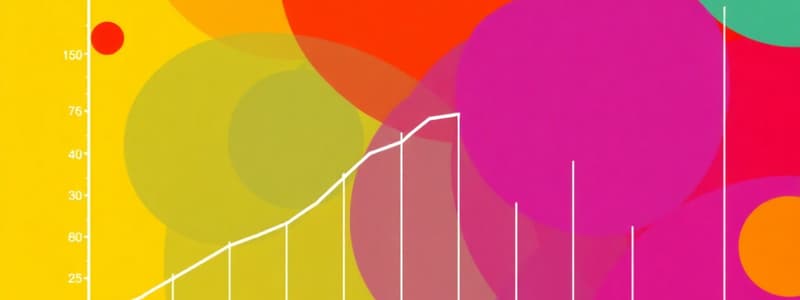Podcast
Questions and Answers
What are the types of statistical methods discussed in the syllabus?
What are the types of statistical methods discussed in the syllabus?
- Descriptive statistics
- Inferential statistics
- Non-parametric statistics
- All of the above (correct)
What does the term 'dispersion' refer to in statistics?
What does the term 'dispersion' refer to in statistics?
It refers to the significance of measuring the spread or variability of a dataset.
Measures of Central Tendency include mean, median, and mode.
Measures of Central Tendency include mean, median, and mode.
True (A)
The mode for grouped data is calculated using the formula: L + (f_1 - f_0) / (2f_1 - f_0 - f_2) * h, where L is the ______.
The mode for grouped data is calculated using the formula: L + (f_1 - f_0) / (2f_1 - f_0 - f_2) * h, where L is the ______.
Match the following statistical terms with their definitions:
Match the following statistical terms with their definitions:
What is the key purpose of the 'Review of Literature' section in a research report?
What is the key purpose of the 'Review of Literature' section in a research report?
Regression analysis is only concerned with simple linear regression.
Regression analysis is only concerned with simple linear regression.
What are the types of statistical methods?
What are the types of statistical methods?
What is the importance of statistics in business decisions?
What is the importance of statistics in business decisions?
Which of the following is a measure of central tendency?
Which of the following is a measure of central tendency?
Match the following measures of dispersion with their definitions:
Match the following measures of dispersion with their definitions:
The median is always the same as the mean.
The median is always the same as the mean.
In correlation analysis, ____ is used to measure the strength of the relationship between two variables.
In correlation analysis, ____ is used to measure the strength of the relationship between two variables.
What is regression analysis used for?
What is regression analysis used for?
Which method is NOT used for time series forecasting?
Which method is NOT used for time series forecasting?
The lower boundary of the modal class is denoted as ____.
The lower boundary of the modal class is denoted as ____.
What is an index number used for?
What is an index number used for?
Which test is used for comparing means in large samples?
Which test is used for comparing means in large samples?
Flashcards are hidden until you start studying
Study Notes
Statistics
- Various statistical methods are used for data analysis.
- Statistics plays a crucial role in business decisions.
- There are different types of data: quantitative (numerical), qualitative (categorical), and time series (data measured over time).
Data Classification, Tabulation and Presentation
- Data classification categorizes information based on specific criteria.
- Tabulation arranges data in a structured format within a table.
- There are various types of tables, including simple, frequency, and contingency tables.
- Diagrammatic presentation uses visual aids, such as charts and graphs, to depict data effectively.
Measures of Central Tendency
- Mean, median, and mode are measures that represent the central value of a dataset.
- Quartiles divide data into four parts, with the second quartile being the median.
- Percentiles divide data into 100 parts.
Dispersion
- Dispersion measures the spread or variability of data.
- Range, standard deviation, and coefficient of variation are common measures of dispersion.
- An outlier is a data point that deviates significantly from the other values.
Correlation Analysis
- Correlation measures the strength and direction of linear relationships between variables.
- Karl Pearson’s coefficient of correlation quantifies the linear relationship between two variables.
- Multiple correlation involves analyzing the relationship between multiple variables.
- Partial correlation involves analyzing the relationship between two variables while controlling for other variables.
Regression Analysis
- Simple linear regression involves finding the best-fitting straight line to describe the relationship between two variables.
- Multiple regression involves finding the best-fitting plane or hyperplane to describe the relationship between multiple variables.
- The coefficients in a regression model represent the estimated effect of each variable on the outcome variable.
- Non-linear regression deals with relationships that are curvilinear.
Index Numbers
- Index numbers are used to measure changes in price, quantity, or other economic variables over time.
- Weighted price indexes take into account the relative importance of different items in a basket of goods or services.
- The Consumer Price Index (CPI) measures changes in the price of a basket of goods and services consumed by urban households.
Forecasting and Time Series Analysis
- Forecasting is the process of predicting future values based on historical data.
- Time series analysis involves examining data collected over time to identify patterns and trends.
- Time series decomposition models break down a time series into its components (trend, seasonality, cyclical, and irregular).
- Quantitative forecasting methods use mathematical models to make predictions.
Distributions
- A distribution describes the frequency of different values in a dataset.
- Different distribution shapes can be observed in datasets.
- The Key parameters for a distribution inform us about specific information about a distribution, for example, the mean of the distribution.
- The typical application column tells us about the area the distribution is typically used.
- The data type column informs us about what data is used in the distribution.
- The Test of significance column informs us about the test(s) that are used to analyze a distribution.
Structure of a Research Report
- A research report typically follows a standard structure.
- The introduction provides background information and defines the research problem.
- The methodology section describes the research design and procedures.
- The review of literature summarizes previous research on the topic.
- The analysis section presents the findings of the research.
- The conclusion summarizes the main findings and discusses their implications.
- The bibliography lists all the sources cited in the report.
Mean for Grouped Data
- The mean for grouped data is calculated by first multiplying the mid-point of each class by its frequency, then summing the products. Finally, divide the sum by the total frequency.
Median for Grouped Data
- The median for grouped data is the value that divides the data into two equal halves.
- It is calculated by first identifying the class that contains the median.
- Then, the median is estimated using the following formula: L + (N/2 - cf)/f * h, where L is the lower boundary of the median class, N is the total frequency, cf is the cumulative frequency of the class preceding the median class, f is the frequency of the median class, and h is the size of the class interval.
Median Vs Quartile Vs Decile vs Percentile
- Median, quartiles, deciles, and percentiles are measures of position that divide a dataset into equal parts.
- The median divides data into two equal halves, quartiles divide data into four equal parts, deciles divide data into ten equal parts, and percentiles divide data into 100 equal parts.
Mode for Grouped Data
- The mode for grouped data is the value that occurs most frequently.
- It is calculated by first identifying the modal class, which is the class with the highest frequency.
- Then, the mode is estimated using the following formula: L + (f_1 - f_0)/(2f_1 - f_0 - f_2) x h, where L is the lower boundary of the modal class, f_1 is the frequency of the modal class, f_0 is the frequency of the class preceding the modal class, f_2 is the frequency of the class succeeding the modal class, and h is the size of the class interval.
Statistics
- Types of statistical methods are used to gather, analyze, and interpret data.
- Statistics are important in business decisions, providing valuable insights for informed choices.
- Data classification, tabulation, and presentation are fundamental techniques for organizing and understanding data.
- Data types categorize the nature of information, commonly classified as quantitative and qualitative.
Data Classification, Tabulation, and Presentation
- Data classification involves organizing data into meaningful categories based on shared attributes.
- Bases of classification include characteristics like age, gender, or income.
- Tabulation presents data in a structured format using tables, facilitating analysis and comparison.
- Objectives of tabulation include summarizing data, highlighting trends, and aiding in interpretation.
- Parts of a table include the title, headings, body, and footnotes, providing comprehensive information.
- Types of tables vary based on purpose and organization, such as frequency distribution, contingency tables, and chronological tables.
- Diagrammatic presentation uses visual representations like charts and graphs to illustrate data patterns.
Measures of Central Tendency
- Measures of central tendency describe the "average" or typical value in a dataset.
- Mean represents the sum of all values divided by the number of values.
- Median is the middle value when data is arranged in ascending order.
- Mode represents the most frequent value in the dataset.
- Quartiles divide a dataset into four equal parts, with the first quartile representing the 25th percentile.
- Percentiles divide a dataset into 100 equal parts, indicating the value below which a certain percentage of data falls.
- Deciles divide a dataset into ten equal parts, similarly representing data distribution.
Dispersion
- Measuring dispersion quantifies the spread or variability of data around the central tendency.
- Range is the difference between the highest and lowest values in a dataset.
- Standard deviation measures the average distance of each value from the mean.
- Coefficient of variation expresses standard deviation as a percentage of the mean, allowing for comparison between datasets with different scales.
- An outlier is an extreme value significantly different from other values in a dataset, potentially affecting the accuracy of statistical analysis.
Correlation Analysis
- Correlation analysis measures the strength and direction of the linear relationship between two variables.
- Karl Pearson's coefficient of correlation (r) quantifies the linear association, ranging from -1 (perfect negative correlation) to +1 (perfect positive correlation).
- Rank correlation assesses the relationship between ranked variables, particularly useful for ordinal data.
- Multiple correlation measures the relationship between one dependent variable and multiple independent variables.
- Partial correlation analyzes the association between two variables while controlling for the influence of other variables.
Regression Analysis
- Regression analysis predicts the value of one variable (dependent variable) based on the value of another variable (independent variable).
- Simple linear regression models a linear relationship between two variables, using a straight line to represent the trend.
- Multiple regression extends the concept to predict a dependent variable using multiple independent variables.
- Estimation of coefficients involves determining the parameters that best fit the regression line.
- Non-linear regression models relationships that are not linear, incorporating curves or different functional forms.
Index Numbers
- Index numbers measure the relative change in a variable over time, comparing current values to a base period.
- Types of index numbers include price indexes, quantity indexes, and value indexes, measuring changes in different aspects of a variable.
- Uses of index numbers include tracking inflation, monitoring economic performance, and comparing prices across different periods or locations.
- Construction methods for index numbers include unweighted and weighted approaches, considering the relative importance of different items.
- Unweighted methods assign equal importance to each item, while weighted methods account for the value or quantity of each item.
- Consumer price index (CPI) measures changes in the price of a basket of goods and services consumed by households.
- Problem in the construction of index numbers include selection bias, weighting issues, and the impact of technological advancements.
Forecasting and Time Series Analysis
- Forecasting involves predicting future values of a variable based on past data and current trends.
- Types of forecasts include qualitative forecasts based on expert judgment and quantitative forecasts based on statistical models.
- Timing of forecasts refers to the timeframe for which forecasts are made, such as short-term, medium-term, or long-term.
- Time series analysis examines data collected over time, identifying patterns and trends for forecasting.
- Forecasting methods include moving averages, exponential smoothing, and autoregressive integrated moving average (ARIMA) models.
- Objectives of time series forecasting include planning, decision-making, and managing resources.
- Steps in forecasting involve collecting data, identifying trends, choosing a forecasting method, and evaluating the forecast.
- Time series decomposition models separate the data into components such as trend, seasonality, and random fluctuations.
- Quantitative forecasting methods use statistical techniques to make predictions, incorporating historical data and relationships between variables.
Distributions
- Distributions describe the pattern or shape of data values, providing insights into the spread and concentration of information.
- Data types, such as continuous or discrete, influence the choice of appropriate statistical methods and tests.
- Tests of significance determine whether observed differences or relationships in data are statistically significant or due to random chance.
Distribution Name Shape Key Parameters Typical Applications Data Type Test of Significance
- Normal Symmetric (bell-shaped) Mean (μ), Standard Deviation (σ) Heights, weights, IQ scores Continuous T-test (for comparing means), Z-test (for large samples), ANOVA (for comparing multiple means)
Studying That Suits You
Use AI to generate personalized quizzes and flashcards to suit your learning preferences.




